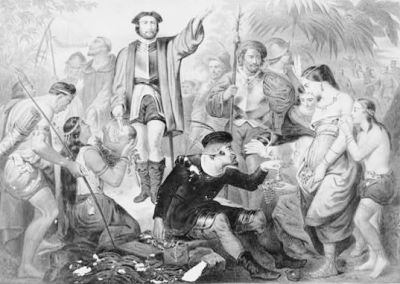Continued from previous issues
Sailing back to Spain after his first voyage for the monarchs, Columbus wrote three letters describing the islands and the people of the uncharted land. The letters were sent to Queen Isabella and King Ferdinand; Luis De Sant Angel (Santangel), who helped finance the voyage; and Gabriel Sanchez, treasurer of the Monarchs. All were hand copied and translated and no original letters have yet been found.
In any online article about Columbus that has a section for comments, it’s inevitable to find numerous negative remarks about him. With the current outbreak of measles in the news, a national newspaper recently published an article blaming “Columbus and his fellow explorers” for bringing the infectious disease to the natives, “one of the many diseases Columbus brought to shore.” That wasn’t enough – Columbus was cited in the headline as the only one responsible for this potentially deadly disease and in the article he alone “took home not just potatoes but also syphilis.”
The website of the Mayo Clinic provides an overview of measles, noting its 10 to 14-day incubation rate, two to three days of early symptoms – moderate fever, continuous coughing, conjunctivitis – and a few days later, a rash.
Considering it took almost five weeks to cross the Atlantic, anyone on the voyage who had the disease would have been very ill (or dead and sent out to sea), and if all were immune, as some report, then how did they infect the natives? Measles may have traversed an ocean, but not personally through Columbus.
Getting back to the online comments about Columbus, along with the usual that he was responsible for genocide and slave trade, chopping off parts of the natives’ bodies and a general overall disgrace to humanity, they now include calls to rename Washington, D.C.
Excerpts from his letters below show how he felt about the natives he met during his first voyage.
From the Sanchez letter: “On the contrary I gave whatever I had, cloth and many other things, to whomsoever I approached, or with whom I could get speech, without any return being made to me; but they are by nature fearful and timid. But when they see that they are safe, and all fear is banished, they are very guileless and honest… They manifest the greatest affection towards all of us, exchanging valuable things for trifles, content with the very least thing or nothing at all. But I forbade giving them a very trifling thing and of no value, such as bits of plates, dishes, or glass; also nails and straps; although it seemed to them, if they could get such, that they had acquired the most beautiful jewels in the world.”
From the Sant Angel letter: “At every point where I landed, and succeeded in talking to them, I gave them some of everything I had – cloth and many other things – without receiving anything in return, but they are a hopelessly timid people. …They never refuse anything that is asked for. They even offer it themselves and show so much love that they would give their very hearts. Whether it be anything of great or small value, with any trifle of whatever kind, they are satisfied. I forbade worthless things being given to them, such as bits of broken bowls, pieces of glass, and old straps, although they were as much pleased to get them as if they were the finest jewels in the world.”
His letter to the monarchs does not provide details about his benevolent treatment of the natives, however, Columbus does write that he has stories to tell and that may be in anticipation of subsequent meetings with the king and queen.
From the Monarchs letter: “They give whatever they have and had for anything that might be given in exchange, even taking a piece of glass or a broken bowl or some such thing for gold or anything else of value; one sailor got more than two and a half castellanos for the ends of his leather laces; there are ten thousand similar stories I could tell.”
For lesson plans about the Columbus Letters, go to http://italamerheritage.com/lesson_plans.htm.
To be continued in a future issue.



